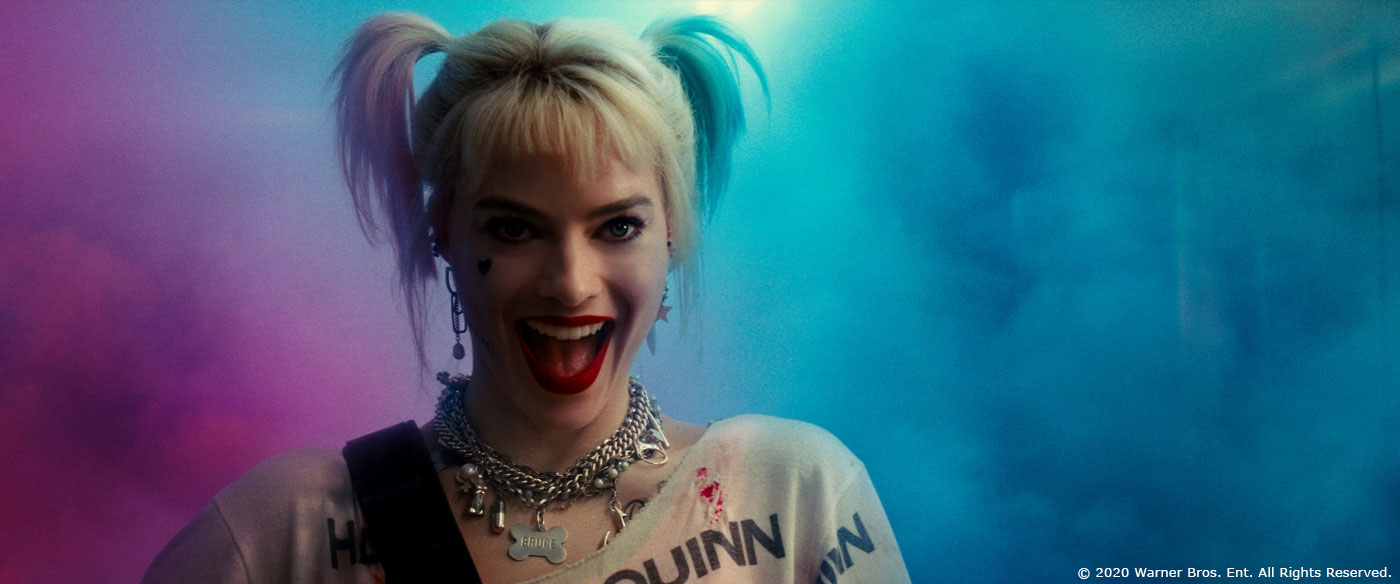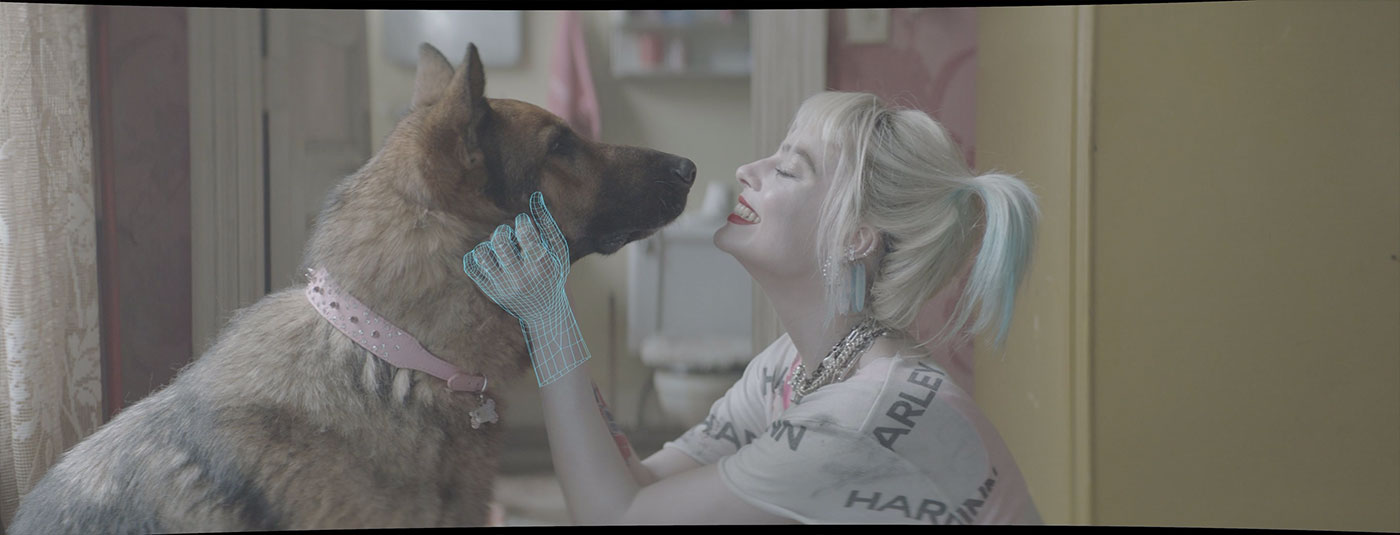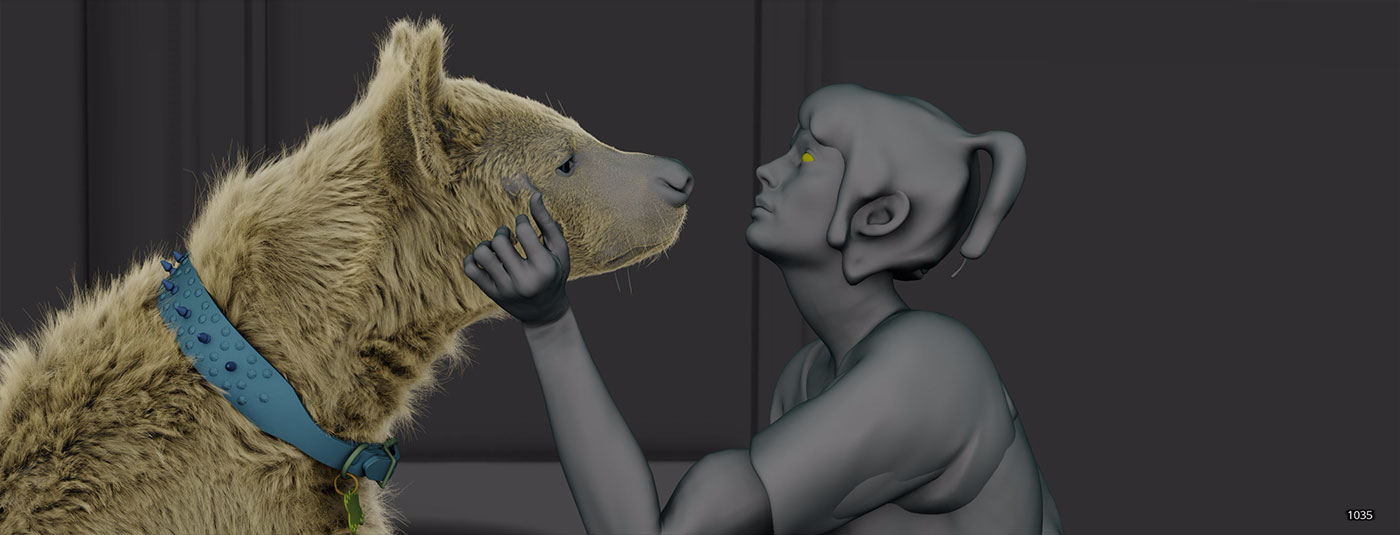Thrain Shadbolt has been working in visual effects for over 16 years. He began his career at Cinesite before joining Weta Digital in 2008. He has worked on numerous projects such as V FOR VENDETTA, AVATAR, DAWN OF THE PLANET OF THE APES, RAMPAGE and THE UMBRELLA ACADEMY.
What is your background?
I’ve been in the film VFX industry since 2004; prior to that I have worked in post-production and computer graphics since the early 90’s.
How was the collaboration with director Cathy Yan and VFX Supervisor Greg Steele?
On a day-to-day basis we dealt with VFX Supervisor Greg Steele, who was supported by VFX Producer Annemarie Griggs. Greg was great to work with, a true gentleman in this industry. He did a fantastic job distilling down the creative notes from Cathy and the studio into easily actionable items.
What was their expectations and approach about the visual effects?
The initial brief to us was the expectation that Bruce – Harley Quinn’s ‘pet’ – would be to all intents and purposes, a real hyena. They did not want a monster, or a cartoon character. Rather, as close to possible to having a hyena on set for the shoot. Hyenas are not easily trained, and are considered dangerous animals to be around. You definitely do not want them near A-list Hollywood actresses. This made it necessary to use a CG hyena for the film.
How did you organize the work with your VFX Producer?
I was lucky enough to have the superb Sophie Ingram looking after production on this show. A challenge for us was keeping a small crew together on a show with a low number of shots but relatively long schedule. It would’ve been easy to burn through our allotted resources all too quickly without careful planning.
What are the sequences made by Weta Digital?
We did all the Bruce related shots, including the sequence where HQ’s apartment is destroyed by a bouncing bomb. We created the ‘Canary Cry’ sequence where we see Black Canary use her superpowers, and we also contributed numerous face replacement and digi-double shots during the police station battle and car chase sequences.
Can you explain in detail about the creation of Bruce the hyena?
At Weta Digital, we have made many furry creatures over the years, so most of the techniques we used on Bruce are well established. We were able to draw on previous quadruped set ups for topology and rigging to get us off to a quick start. For Bruce specific details, we based him largely on photography of a real hyena provided to us by the production. We also mixed in some aspects of other hyenas we saw in wildlife references. The biggest challenge in the asset creation proved to be the fur ‘groom’. Bruce had a thick shaggy coat and mane that was quite unique. It took some iterations to get this right, but it gave him a distinctive, attractive look quite different from the typical scrawny hyenas we often see in films, and was a big hit with Cathy.
How did you handle the hyena interactions with Margot Robbie?
The production made the excellent call to use a well trained German Shepherd called ‘Varko’ as a stand in for Bruce. This gave Margot a partner to act with, as well as providing us with a reference both for performance and lighting. From observing her interactions with Varko, we were able to appreciate how much the dog’s skin moved when stroked, as well as the fur.
This insight led us to a multi-stage process; we would simulate hand collisions with the skin, which would then drive additional motion and interactions with the fur. These rendered interactions would then be further sweetened in Comp; motion vectors derived from the fur in the plate would drive further motion on the CG. To help sink the fingers into the fur, we would also ‘cheat’ a little and use small parts of the dogs fur around the fingertips, graded to match the hyena. We really had to be able to believe that the two were in contact; this process helped make that convincing.
Can you tell us more about the rigging and animation?
The creature rig was broadly based on previous quadruped rigs, but with specific facial shapes unique to hyenas. To get into character, Animation Supervisor Aidan Martin and his team spent a lot of time looking at wildlife reference and identifying the characteristics of hyena motion, like their lolloping gait.
Did you received specific indications and references for the animation?
The performance of Varko was used as a starting point, as generally that meant the broad strokes were already approved by Cathy. However, we also looked at a lot of hyena wildlife reference for inspiration, as a hyena is of course, not a dog (in fact they are related genetically to cats!), and they have some specific behaviours and expressions such as the snarl, that appear quite different. Bruce ended up being a synthesis of both, so that he had characteristics of a pet, but retained some of the wildness of a real hyena.
What was the main challenge with the hyena?
Perhaps the biggest challenge was trying to fit Bruce into shots in the space occupied by Varko; being substantially bigger than the dog, and with a long hyena neck, it was sometimes difficult to be able to pose him within the same space, and have him also meet Margot’s hands for interactions.
How did you handle the lighting challenges?
Most of our shots required putting Bruce or other elements into the plate. Ideally, this works best with good data from the set. We did not have a presence on set for this show, but luckily for us, Greg and his team did an excellent job capturing all the information we needed, this primarily being HDRI for each lighting set up, along with reference plates of grey and silver spheres under the same lights, and a LIDAR survey of the set. With this data we were able to use Weta’s well established lighting pipeline effectively.
Canary has a super power with her scream. Can you elaborates about its design and creation?
We had to do some creative exploration here. The essential challenge was how to visualise a superpower that is defined as shockwaves of sound, in an original way. There was prior art in the comics as to how the Canary Cry looks, as well as in the Birds of Prey and Arrow TV series. So we took a look at these, along with other interesting references from the real world, like various shockwaves and explosions. We wanted to find an effect that looked like it could be a plausible physical event, and not something too magical. In our initial tests we tried a number of different styles for the ‘Cry’, from smoky and dusty, through glassy and refractive, to more electric. Eventually Greg and Cathy settled on a subtle combination of these various aspects.
How did you animate and simulate the FX elements of her power?
The realisation of the Canary Cry effect was a combined effort from the FX and Compositing teams. We created a number of different animated passes in Houdini; elements like concentric radiating rings, volumetric dust clouds, particles, normals passes and so on. These were then tuned in Comp, balancing the amount of refractive distortion to the plate against the density of dust, and strength of effects like chromatic aberration. Within the frame enemy goons that are blasted back were multiple plates of stunt men, rotoscoped and re-arranged in the comp. These were then given 3d match moves, so that we could have additional particle system interacting with them, heightening the effect of the shockwaves knocking them off their feet.
Which stunt was the most complicate to enhance?
It’s hard to say which was the most difficult, but one that stood out was a shot where HQ goes into a sliding kick towards camera, knocking a bad guy off his feet. This was a very unforgiving face replacement, that included a camera re-speed for a ‘bullet time’ feel, and a plate shot with rain effects. This made the integration of the face particularly challenging, however Comp did a great job with this and it’s visually seamless.
Can you tell us more about your face replacements work?
Margot was able to perform many of her own stunts, but some of them were too extreme for that to be practical, so they were filmed with a stunt double instead – which is why we were required to do a number of face replacements. Many of these we were able to do solely in comp. For these kind of shots, we would take a secondary performance plate of Margot acting out the action in a controlled and safe manner. Compositing Supervisor Mark Richardson and his team would carefully select frames of Margot that were suitable, then using proprietary optical flow tracking tools, seamlessly merge these into the hero plate. We would often have to compensate in comp for the difference in physique of the stunt double, who was stockier than Margot; shrinking her shoulders and arms, and making her neck look longer.
These techniques worked well for many shots, however some required a fully CG head. For this we worked with the ICT lab; Margot’s face was scanned using their tools, and the models and textures were delivered to us to be incorporated into a fully renderable HQ face asset. This let us pull off shots with lots of rotation, or where there was no suitable Margot plate. 3d match-moves would align the CG head to the stunt woman, then animators would create a performance. The animated face would be passed to lighting, using the HDRI pipeline to render these in our path-tracing renderer ‘Manuka’. Comp would put the finishing touch on this and merge it into the hero plate.
Which sequence or shot was the most challenging?
The work on Bruce aside, we had a couple of very challenging shots during the car chase sequence. These shots required secondary plates of the car chasing HQ then crashing, to be incorporated into the main plate tracking shot, which contained HQ in the FG. Given the fact that both A and B plates were shot without motion control, and the B plate needed to have digi-doubles inserted, while also being retimed, meant it was always going to be a challenge. To make this work, both plates were first aligned in 3d space to LIDAR of the set, and cameras tracked. This gave us the ability to line both shots up in the world. Comp was then able to re-project the B plate, with a lot of work, to fit into the A plate. Some digital matte painting work cleaned up parts of the combined plate that were missing.
Is there something specific that gives you some really short nights?
There was a moment, close to the end of the schedule, where we thought we might need to have two hyenas in the film! Luckily for us, that did not eventuate.
What is your favorite shot or sequence?
Perhaps my favourite shot was also the first shot we worked on. Bruce is sitting on the floor of HQ’s apartment, gnawing on the leg bone of the unfortunate animal breeder whose shop Bruce was discovered in. Meanwhile, HQ has her legs resting on him, while she downs a tub of ice cream. This shot went through a lot of iterations as we developed Bruce, and was particularly challenging given that in the plate Margot’s legs rested atop Varko, who is substantially smaller. So in addition to all the work adding Bruce to the plate, we also had to reconstruct and animate Margot’s legs. This we did entirely in Comp, which worked well in this case, and avoided the need for a digi-double. The finished shot looked good and was technically challenging – but also demonstrated the off-beat black humour of the film, and gives us our first good look at Bruce.
What is your best memory on this show?
No one specific memory, but it was a great show to work on. Being a small show, all members of the team were able to be intimately involved with the work, and I was personally able to light some of the shots, which is not something I often have time for on larger shows, where I can spend most of my day in reviews and meetings!
How long have you worked on this show?
From beginning to end, we spent about a year on this show.
What’s the VFX shots count?
BOP was a relatively small show for Weta Digital, starting out at around 30 shots, mainly related to Bruce. As time went by and we gained the confidence of the client, they entrusted us with more work, leading to an eventual shot count of 65.
What was the size of your team?
As the show made its way through the facility, many artists contributed, but the core team was small, probably around 25 people.
What is your next project?
I can’t say just yet.
What are the four movies that gave you the passion for cinema?
Happy to say I’m a sci-fi geek, and these inspired not just a love for cinema but also VFX: STAR WARS, BLADE RUNNER, ALIEN(S) and TERMINATOR 2.
A big thanks for your time.
WANT TO KNOW MORE?
Weta Digital: Dedicated page about BIRDS OF PREY on Weta Digital website.
© Vincent Frei – The Art of VFX – 2020










